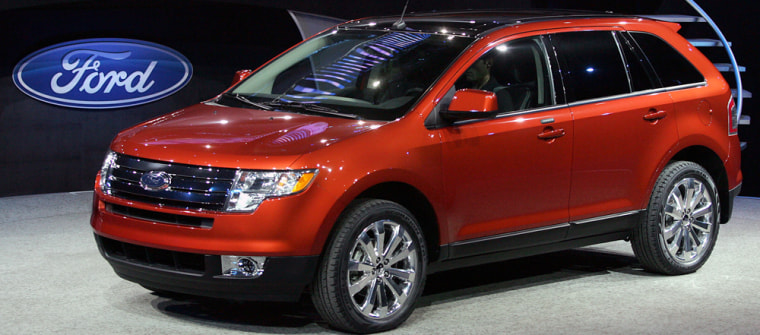Ford Motor Co. is counting on its 2007 lineup with new crossovers and all-wheel-drive cars to help slow its declining market share.
Now it just needs to convince consumers.
The nation’s second-largest automaker unveiled its new models on Wednesday when its stock hovered near a more than 13-year low and a report came out that car buyers are losing more of their appetite for new midsize sport utility vehicles.
Ford’s new models include the sleek, five-passenger Edge crossover vehicle, which hits showroom floors in November, and a Lincoln version called the MKX.
The company also reworked its Expedition SUV and added an extra-long model with more storage capacity, plus Lincoln counterparts, the Navigator and Navigator L.
Ford did not introduce any completely new cars, but it is offering all-wheel-drive in the Ford Fusion, Mercury Milan and Lincoln MKZ models. The MKZ replaced the Zephyr. It also will roll out the new Shelby GT500, the most powerful factory-built Mustang ever, powered by a growling 500 horsepower V-8.
Mark Fields, president of the Americas division, said the new models, plus behind-the-scenes development of future products, have the company on target to reach its goal of returning to profitability in North America by 2008.
“We remain very, very committed to this and we are on track,” he told reporters at the company’s new development center near its Dearborn headquarters.
Peter Morici, an economist and professor at the University of Maryland School of Business, was skeptical, however, saying that Ford isn’t offering enough fresh vehicles to ignite consumer enthusiasm
“The basic problem here is that we’ve seen most of what Ford has for this cycle, and most of it has not caught fire,” he said. “They’re not getting anywhere. They’re making better cars, but everyone is making better cars.”
Fields acknowledged that the market is shifting away from trucks and SUVs, once Ford’s profit center, to crossovers and cars, but said the company should be able to build on sales of its top-selling Fusion and Milan cars.
“We’re still not even where we need to be in terms of awareness of those vehicles,” he said. “And that’s why you see us advertising consistently and not launching and abandoning as we have in the past.”
Ford’s announcement also came as J.D. Power and Associates reported that consumer demand for new midsize SUVs continued to slow.
The segment, made up of traditional midsize SUVs, currently records the second-longest length of time on dealership lots among the 26 segments tracked by the Westlake Village, Calif.-based auto information company.
J.D. Power said Tuesday it used real-time retail transaction data from its Power Information Network.
Midsize SUVs sold in May sat on dealership lots an average of 73 days. The only group with a higher rate was full-size vans, which sat for 80 days before being sold.
Compact cars sold in May spent just 35 days on lots.
Ford and the other two domestic auto makers are facing hard times as they take high costs and aging models into battle against foreign-based competitors.
Ford’s U.S. market share fell to 17.6 percent in the first quarter, down from 18.2 percent the previous year. The company also lost $1.2 billion in the first quarter of this year.
The company unveiled a turnaround plan in January called “The Way Forward,” which includes closure of 14 plants by 2012 and cutting up to 30,000 hourly workers in North America. It also plans to speed up new model development to keep its products fresh.
Some analysts have said the plan is moving too slowly, but Fields said that was typical Wall Street talk.
Ford’s stock price has steadily fallen, closing Tuesday at a 52-week low of $6.40. On Wednesday, its shares closed 3 cents higher on the New York Stock Exchange.
Fields said he saw the same reaction on Wall Street as he did when he led a resurgence at Mazda and said the company remains "committed” to its turnaround target of making its auto business profitable again by 2008.
“I don’t spend a lot of time worrying about what the outside world thinks,” Fields said Wednesday. “You know this business: There’s a certain gestation period.”
“We remain very, very committed to this,” he said of the 2008 goal. “I am happy where we are right now. In some areas we are ahead; in some areas we are behind; but we are where we expected.”
Fields also said the company is committed to keeping its substantial manufacturing presence in the U.S. The company last week announced plans to expand three plants in Mexico, touching off fears that it would shift labor to get lower costs south of the border.
About 90 percent of Ford’s capital spending is done in North America, Fields said.
“Clearly the bulk of our presence is here in the U.S., and we’re a big driver of the economy. I don’t expect that to change very appreciably,” he said. “But at the same time we need to make sure we run a profitable business.”
